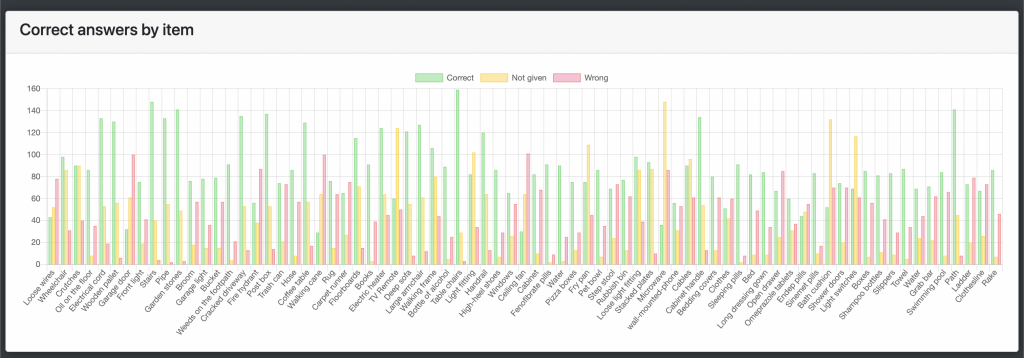The advantages of teaching students on the metaverse!
By adopting the latest developments in the metaverse, learning and development professionals, as well as educational institutions, HR, and training departments, can take the lead. Curtin University is a great example of this. The organization has developed an award-winning platform with LearnBrite that enables trainee health and community professionals to develop their real-world physiotherapy skills in a virtual setting.
The initial project started in 2015 is still being updated and used by the university’s students. Multiple other learning activities have been added over the years, for the students to experience and learn by doing without the risk of failure and without any risk to patients.
“At this stage, an Interprofessional Virtual Hospital Visit (IPE VHsV) has been developed for physiotherapy, pharmacy, social work, and psychology disciplines. Once students from these disciplines have completed their discipline-specific IPE VHsV they attend a virtual team meeting.”- Anne Furness
So it’s only natural to say that Curtin University is one of the first universities to join the Metaverse for learning.
About Curtin University
Curtin University is a university with campuses in Australia, Malaysia, Singapore, Mauritius, and Dubai. As part of their portfolio, the institution runs a physiotherapy program along with other health care disciplines.
Why did Curtin University want to create a metaverse platform?
The understanding that projections for the population growth for those aged 65 years and older are in the order of a 200% increase by 2061 and that people are keen to remain living in their homes for as long as possible meant that the physiotherapy curriculum required the inclusion of learning activities that provide students with clinical skills that allow them to deliver future care for the aging population.
Virtual Learning activities provide students with authentic learning experiences that would otherwise not be available due to an insufficient number of clinical placements.
In addition, a metaverse platform:
- Is cost effective
Clinical placements are expensive both for the organizer (provision of supervisor by the university), as well as participants (cost of travel). This expense can impact availability.
- Provides flexible learning
Students undertake the learning activities anytime, anywhere. The time that is saved traveling to and from a location can be used to consolidate learning. Also, virtual learning activities address the time-tabling challenges involved when learning activities include students from various disciplines.
- Encourages self-directed learning
Provides students with opportunities to develop and practice skills that they would otherwise not have; assessment of falls risk identification in the hospital and home, team meetings
How did LearnBrite and MootUp help?
LearnBrite is a fully accessible browser-based platform that can be accessed by large numbers of learners on any device, including VR/ AR and on any operating system, from anywhere in the world. The learner can undertake the virtual learning activity (play the game) as many times as they wish to practice their skills and so learn at their own speed.
As technology is an integral part of how we live, it is important to provide experiences/practice in using technology to prepare learners for the real world. The learner may not want heavy gamer computers or have funds to spare for VR equipment. The virtual learning activities developed to give the learner the option to join on their own devices without having to download and install any apps.
LearnBrite collaborated with Curtin University to develop initially a Virtual Home Visit (VHV), then a Virtual Hospital Visit (VHsV), and an Interprofessional Virtual Hospital Visit (IPE VHsV). These learning activities were customized to provide a platform that maximizes learning opportunities with authentic environments that place trainee health and community professionals in situations where they make prompt judgments about patient wellbeing.
Specific features within these learning activities include:
- Flexible team meetings
The IPE VHsV learning activity includes a virtual team meeting where students from various disciplines can discuss and develop an integrated care plan for the patient interviewed during the discipline-specific IPE VHsV. Because these meetings take place online, there is no need for room bookings and the meetings can be scheduled at the most convenient time for the students.
“The processes involved address the logistical issues of timetabling students and room bookings. Students on country placements can also participate.” – Anne Furness
- Virtual student training and personalized learning
It is important for all health care workers to manage risk because this saves lives, reduces the incidence of injuries, and helps prevent other negative outcomes. The VHV mimics the reality of a patient’s home and lets learners practice making risk assessments based on 15 categories including trip, slip, diet, and medication.
The immersive environments and branching scenarios put the learner first and enable a personalized training experience. This experience provides the learner with an understanding of what they will be expected to do in the clinical environment.
“This learning activity provides students with an experience that is similar to one they would have in the clinical setting.”- Anne Furness
- Improved student assessment
While enabling students to improve their skills as physiotherapists, VHV also assesses users’ reactions along with a number of different metrics, for example:
- Which risk-objects were found in the 3D environment
- The risk categories assigned to each object found in the virtual environment
- Which knowledge factors were identified in the conversations with the AI chatbots
- Number of visits to the virtual world
- The time spent in the Curtin University spaces, virtual world, across the entire Curtin metaverse
- How many conversations were initiated and duration, to name a few.
- More student fun and socializing

Research suggests that better learning happens when classroom experiences are enjoyable, and the Virtual Learning Activities leverage fun. The virtual world is like a videogame, which means the experience for the learner is less didactic and more immersive and joyful. The multiuser settings also create social moments and chances for trainees to chat with their peers.
- Cost savings
As well as offering greater flexibility and improving the student learning experience, the Virtual Learning Activities are cost-effective. In fact, because students can use the Virtual Learning Activities themselves without the direct aid of teachers, educational institutions can save tens of thousands of dollars.
With LearnBrite you can design and develop immersive branching scenarios that can be immediately deployed to the platform and available for testing and modification without needing to reshoot any scenes or record new voiceovers making a production that much easier and cost-effective.
The platform is also a no-code platform, which means you do not need an army of developers to code and deploy new scenes or modifications. LearnBrite does all the heavy lifting for you.
Is Curtin University platform a success?
The VHV was presented by Curtin University Director of Teaching & Learning Anne Furness at the World Confederation for Physical Therapy in Singapore in 2015.
At the conference keynote speaker, Dr. Ah-Cheng Goh said – in support of the use of VR in educational settings: “Virtual reality to teach and assess a student’s ability to examine a patient and arrive at a diagnosis or problem list has great potential as a teaching tool.”
In addition, the development of VHV by Curtin University and LearnBrite was recognized at the Curtin Commercial Innovation awards where Anne Furness and her team won the Teaching and Learning Award.
In terms of the user experiences, reviews of the Virtual Learning activities have been very favorable. One student said about the Team Meeting in MootUp:
“The sit-down virtual meeting was fun and made it easier for it to feel like an actual meeting.”
Another participant commended the “realistic scenario” of the virtual world.
Here are a few more student reactions and comments.
“Seeing a patient in a room just before an interprofessional team meeting was quite realistic and made it easy to keep them at the focus of care.”-IPE VHsV Student
“It’s nice to put a face to a person’s voice while somehow keeping anonymous”-IPE VHsV Student
Take students to the metaverse with LearnBrite!
LearnBrite is a relative metaverse veteran with seven years of experience in the sector. The virtual reality company stands out for its ability to provide fun and innovative solutions to soft skill training across a wide range of industries such as healthcare, construction, marketing, sales, to name a few.
LearnBrite is also highly adaptable with integration options with the most popular learning management systems such as Moodle and Blackboard. Metaverse learning experiences improve educational outcomes and save money.
To discover the new virtual world click here.
